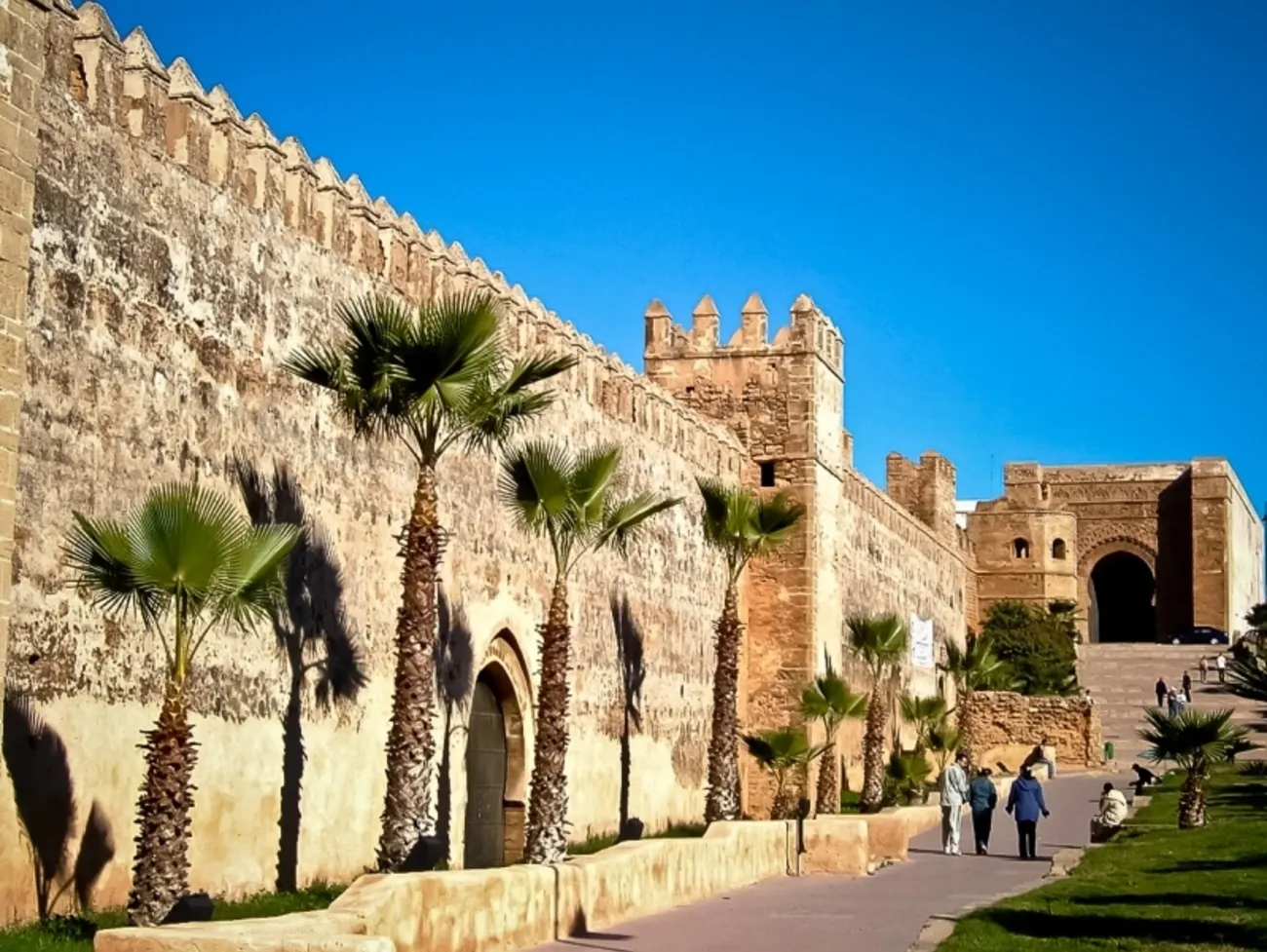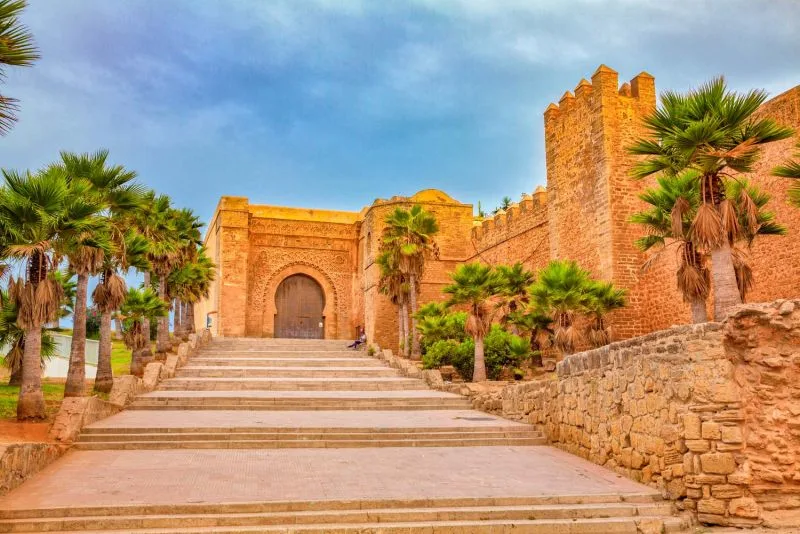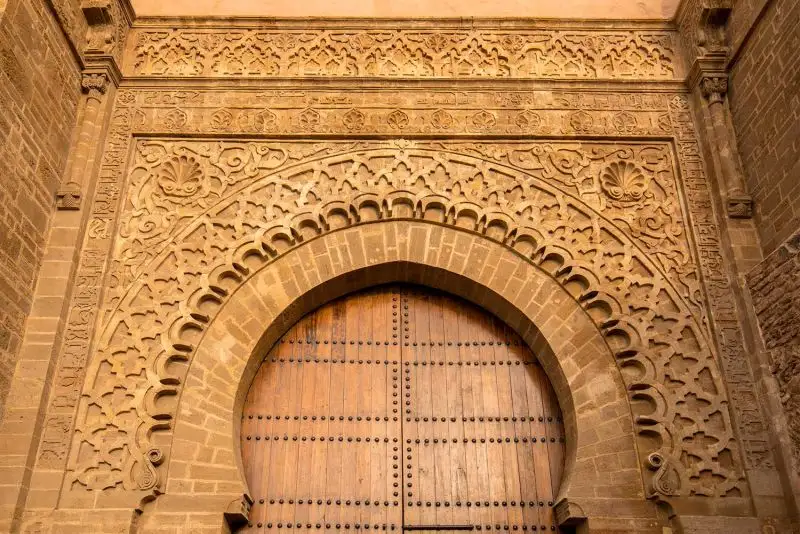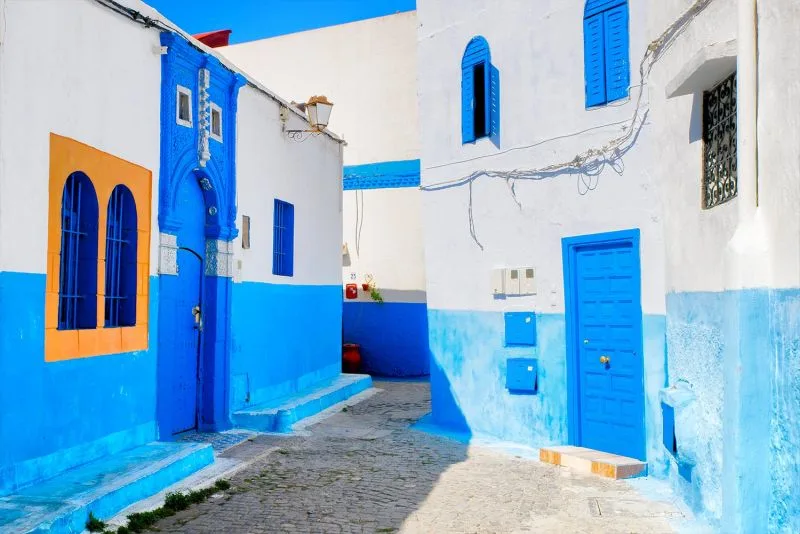Why the Oudaya Kasbah Should Be Your Next Morocco Adventure
The Oudaya Kasbah in Rabat is one of Morocco’s most enchanting landmarks, overlooking the Bou Regreg River. This UNESCO World Heritage site blends Moroccan, Andalusian, and Islamic artistry within its blue-and-white walls. From the grand Bab Oudaya gate to peaceful gardens and ocean views, every corner reveals Morocco’s timeless charm and cultural depth.

Picture a fortress where nearly a thousand years of Moroccan history unfold within ancient stone walls. The Oudaya Kasbah emerges from the strategic mouth of the Bou Regreg river, facing the historic city of Salé across shimmering waters. This extraordinary citadel captured UNESCO's attention in 2012, earning its place on the World Heritage List for its remarkable fusion of historical preservation and cultural significance.
What stories does this Moroccan kasbah hold within its weathered ramparts? The fortress began life as a modest military bunker, yet its destiny proved far grander. Across ten centuries, waves of abandonment and occupation have swept through its courtyards, each era leaving distinctive marks upon its architecture. The structures visitors encounter today primarily echo the 12th century, when Almohad caliph Abd al-Mu'min erected a new citadel atop an earlier ribat in 1150. The kasbah draws its current name from the Udaya tribe, whose members once held dominion over these commanding heights. Within these walls, Andalusian refugees have sought sanctuary, Arab tribes have established their quarters, and Morocco's most influential sultans have wielded their power.
This guide unfolds the compelling reasons why the Oudaya Kasbah deserves a place on your Moroccan itinerary. From architectural marvels that span centuries to strategic importance that shaped regional history, discover the cultural treasures that continue to captivate visitors within this living monument.
The origins of the Oudaya Kasbah
Beneath the Oudaya Kasbah's current stone facade lies a palimpsest of Moroccan history, where each archaeological layer whispers tales of different eras. The fortress we explore today represents merely the final chapter in a millennium-long story of construction, destruction, and renewal.
From ribat to kasbah: early foundations
The 10th century witnessed the emergence of the first fortified structure at this strategic location, when the Umayyads of Cordoba or their Zenata Berber allies established a ribat (fortified monastery) upon what scholars believe corresponds to the current kasbah site. This early religious-military outpost stood sentinel against the Barghawata Berbers, who had carved out their own independent state to the south.
Centuries later, as the Almoravid dynasty faced its twilight, one of their final rulers, Tashfin ibn Ali (1143-1145), erected a new ribat during his desperate struggle against the ascending Almohad Caliphate. Yet history had already chosen its victor; the Almohads swept through the region, dismantling the ribat as they established their dominance.
The Almohad era and the rise of Rabat
The architectural foundation that visitors recognize today emerged between 1150 and 1151, when Almohad caliph Abd al-Mu'min constructed a new kasbah directly atop the ruins of the former ribat. This visionary ruler created more than a military installation; his complex encompassed a palace and mosque, while engineers carved an underground canal system that would sustain future urban development.
The kasbah's golden age arrived under Yaqub al-Mansour (1184-1199), whose ambitious vision extended far beyond the original fortress walls. This remarkable caliph dreamed of creating Ribat al-Fath, a grand imperial capital that would dwarf the modest kasbah. His architectural legacy endures in the magnificent Bab Oudaya (also known as Bab al-Kbir), whose pointed horseshoe arch and elaborate geometric decorations continue to mesmerize visitors eight centuries later.
The Udaya tribe and their legacy
The subsequent centuries brought alternating periods of splendor and abandonment to the kasbah's courtyards. A watershed moment arrived in 1609, when approximately 2,000 Moriscos Muslims expelled from Spain sought refuge within and around the fortress. These determined refugees would establish the autonomous Republic of Salé, transforming their sanctuary into the notorious headquarters of the "Salé Rovers," corsairs whose maritime raids terrorized European merchant vessels throughout the Atlantic.
The fortress acquired its current name through a curious historical coincidence that unfolded during the 19th century. Sultan Moulay Ismail had previously stationed members of the Udaya guich (army) tribe within the kasbah to maintain order among rebellious regional tribes. However, the name "Oudaya" became permanently associated with the fortress only after Sultan Abd ar-Rahman expelled the tribe from Fez, forcing its surviving members to seek shelter within the ancient walls.
Discover the timeless charm of the Oudaya Kasbah with our Morocco travel packages. Explore Rabat’s blue alleys, historic gates, and riverfront views on your next Moroccan adventure!

You'll need 1.5 to 2 hours to explore comfortably enough time for the blue streets, Andalusian Gardens, museum, and ocean viewpoint.
Architectural highlights of the kasbah
Each step through the Oudaya Kasbah unveils architectural treasures that chronicle Morocco's cultural evolution across centuries. These structures stand as silent witnesses to the kasbah's remarkable journey, from Almohad grandeur to Andalusian refinement.
Bab Oudaya: the ceremonial Almohad gate
Yaqub al-Mansour's architectural vision reaches its pinnacle at the magnificent Bab Oudaya, erected in 1195. This monumental entrance commands attention not through military necessity, but through ceremonial splendor, its facade oriented toward the city's heart. The horseshoe arch entrance displays intricate geometric patterns known as "darj wa ktaf," creating visual poetry in stone. Particularly fascinating are the serpentine "S"-shaped forms adorning the arch corners believed to represent eels; these motifs stand virtually alone in Moroccan architectural tradition. Beyond the impressive exterior, three interconnected chambers create a bent passage, each showcasing distinct vaulting techniques that demonstrate medieval engineering mastery.
The Old Mosque: spiritual heart of the kasbah
Rabat's oldest mosque, the Jama' al-'Atiqa, anchors the kasbah's spiritual landscape. Abd al-Mu'min's original 1150 construction received extensive 18th-century restoration, funded remarkably by Ahmed El-Inglizi, an English corsair who had embraced Islam. The minaret rises elegantly, its small decorative arcades reflecting the refined craftsmanship that characterized early Alaouite architectural patronage. Inside, the prayer hall adopts the classic "T"-plan configuration typical of medieval Moroccan mosque design, featuring seven naves that flow perpendicular to the qibla wall.
Oudayas Museum: from palace to cultural hub
Sultan Moulay Ismail's residential palace, constructed between 1672 and 1694, now serves as the National Jewelry Museum, showcasing Andalusian architectural influences throughout its design. The 1995 renovation revealed spaces that house extraordinary collections of manuscripts that record centuries of learning, coins that trace economic history, astrolabes that guided ancient navigators, alongside textiles, carpets, and jewelry representing Morocco's diverse regions [121]. The structure centers around a traditional Moroccan riad courtyard, while its distinctive exterior tower adds vertical emphasis to the complex.
Andalusian Garden: a colonial-era creation
Adjacent to the museum, the Andalusian Garden presents architect Tranchant De Lunel's 1920s interpretation of traditional Islamic garden design. Though created during the French Protectorate period, these gardens authentically capture Andalusian stylistic principles in their layout and aesthetic philosophy. The 8,400 square meters occupy the footprint of earlier sultanic gardens, maintaining historical continuity through landscape. Rectangular garden sections feature tile-decorated water features and fountains that create cooling microclimates. The botanical collection includes laurel roses, citrus varieties including orange and lemon trees, banana palms, and datura, creating a verdant sanctuary within the ancient fortress walls.

Oudaya is famous for its blue-and-white Andalusian streets, stunning Atlantic views, peaceful Andalusian Gardens, and photogenic alleyways. It's Rabat's most Instagram-worthy spot.
Strategic and cultural significance through time
Beyond its architectural splendor, the Oudaya Kasbah has wielded remarkable influence as a nexus of political authority, cultural transformation, and historical importance across multiple centuries.
The Republic of Salé and corsair history
The arrival of Morisco refugees in 1609 sparked one of the kasbah's most fascinating chapters. These displaced communities created the autonomous Republic of Salé (also called the Republic of Bou Regreg), an independent maritime state that flourished for 44 years between 1624 and 1668. The republic gained notoriety as the operational base for the legendary "Salé Rovers"—skilled corsairs whose maritime prowess terrorized European merchant vessels across the Mediterranean. Strategic military additions transformed the fortress during this era: engineers constructed a sophisticated signaling platform along the northeastern edge, while the notorious "Tower of the Corsairs" concealed powerful cannons designed to ambush pursuing enemy ships. This autonomous republic operated completely outside central Moroccan authority until Sultan Moulay Rashid finally brought it under imperial control in 1666.
French protectorate and restoration efforts
The dawn of the 20th century marked a pivotal restoration period when French colonial authorities initiated extensive preservation work in 1914. Architect Maurice Tranchant collaborated with master craftsmen such as Hadj Driss Tourouguy to reshape the kasbah's physical appearance while preserving its historical essence. Parallel to these architectural interventions, French administrators established the Oudayas Museum in 1915, creating one of Morocco's pioneering cultural institutions. These preservation efforts served dual purposes: protecting indigenous artistic traditions while simultaneously reinforcing colonial administrative legitimacy through cultural stewardship.
UNESCO recognition and heritage value
International recognition arrived in 2012 when the Oudaya Kasbah achieved UNESCO World Heritage status. Designated as part of "Rabat, Modern Capital and Historic City: a Shared Heritage", the fortress exemplifies how historical preservation can coexist harmoniously with contemporary urban development. The kasbah now stands as a magnificent testament to Morocco's multicultural architectural heritage, where Berber, Arab, and Andalusian design traditions converge. UNESCO's designation celebrates its "outstanding universal value and contribution to humanity's cultural heritage", elevating this Moroccan fortress to a position of global cultural significance that transcends national boundaries.

A kasbah is a fortified citadel or walled medina on elevated ground, serving as a military fortress, administrative center, and protected residential area for ruling families.
Customize Your Dream Vacation!
Get in touch with our local experts for an unforgettable journey.
Plan Your TripWhat to see today in the Oudaya Kasbah
The modern Oudaya Kasbah beckons visitors into a sensory exploration where Morocco's living heritage unfolds at every turn. This ancient fortress maintains its authentic pulse, weaving together centuries of history with the rhythms of contemporary daily life.
Blue and white alleyways of the residential quarter
The Oudaya Kasbah continues to thrive as a residential neighborhood, distinguished by its Mediterranean character that sets it apart from other Moroccan quarters. Every surface within this UNESCO World Heritage site displays a captivating palette of blue and white. Scholars propose various theories for these distinctive hues: spiritual protection against malevolent forces, Jewish traditions introduced during the 1930s, natural mosquito deterrence, or simply the quarter's signature aesthetic identity. The narrow, winding passages create a labyrinthine experience where authentic local life unfolds naturally. Potted plants cascade from doorways, ornate wooden doors guard family courtyards, and wrought-iron balconies frame glimpses into this living community.
Café Maure and the view from the semaphore platform
Few experiences within the kasbah match the allure of Café Maure, which has welcomed visitors since 1922. Recent restoration work, involving an investment of approximately 625 million MAD (70 million USD), has renewed this legendary establishment while preserving its timeless character. Here, guests savor aromatic mint tea accompanied by traditional almond cakes known as ghriba. The café's true magic reveals itself beyond these culinary pleasures. The adjacent semaphore platform, positioned at the kasbah's northeastern corner, offers one of Morocco's most spectacular vantage points. This strategic location, once essential for spotting approaching vessels, now rewards visitors with sweeping panoramas of the Atlantic Ocean, the Bou Regreg estuary, and the historic city of Salé stretching across the water.
Local crafts and carpet weaving cooperatives
The main square houses a remarkable carpet-weaving cooperative within the walls of a converted 18th-century warehouse. Visitors can observe master artisans practicing textile traditions passed down through generations, their skilled hands creating intricate Moroccan carpets using techniques unchanged for centuries. The cooperative sits along Rue Jamaa, the main thoroughfare that guides visitors directly toward the semaphore platform, making it a natural stop during any exploration of the kasbah's treasures.
Built in 1540, Agadir Oufella symbolizes the city's heritage and resilience. Though destroyed in the 1960 earthquake, its hilltop ruins at 236 meters elevation remain cultural landmarks with panoramic bay views.
Conclusion
Few historical sites achieve what the Oudaya Kasbah accomplishes with such graceful authenticity. This ancient fortress weaves together Morocco's most compelling historical threads from medieval military strategy to corsair adventures, from Andalusian architectural mastery to contemporary residential life. Each cobblestone pathway and weathered wall speaks to centuries of adaptation, resilience, and cultural fusion that define Morocco's extraordinary heritage.
The kasbah's architectural legacy alone justifies its UNESCO recognition. Bab Oudaya's ceremonial grandeur, the Old Mosque's spiritual continuity, and the museum's palatial elegance create a remarkable ensemble of Islamic architectural achievement. Yet these monuments gain deeper meaning when experienced alongside the vibrant blue and white residential quarter, where families continue traditions that stretch back generations.
Standing upon the semaphore platform with mint tea warming your hands, the Atlantic horizon stretches endlessly before you while Salé's ancient rooftops catch the afternoon light. This moment crystallizes the kasbah's enduring appeal—its ability to transport visitors across time while remaining firmly rooted in present-day Moroccan culture. The carpet weavers' cooperative, the bustling alleyways, and the gardens' tranquil beauty demonstrate how historical preservation can enhance rather than diminish living communities.
Morocco offers many magnificent destinations, yet the Oudaya Kasbah presents something uniquely valuable: an authentic encounter with a millennium of North African civilization. Within its walls, Berber, Arab, Andalusian, and contemporary Moroccan identities merge seamlessly, creating an educational experience that enriches understanding while delighting the senses.
Your Moroccan adventure awaits within these storied ramparts. The fortress that once sheltered corsairs and sultans now welcomes curious travelers seeking genuine cultural immersion. Step through Bab Oudaya's ancient archway and discover why this remarkable kasbah continues to captivate visitors nearly a thousand years after its foundation.
FAQs
Q1. What makes the Oudaya Kasbah a must-visit destination in Morocco?
The Oudaya Kasbah is a UNESCO World Heritage site known for its stunning blue and white alleyways, panoramic views of the Atlantic Ocean and Bou Regreg river, and rich history dating back nearly 1000 years. It offers a unique blend of historical architecture, cultural experiences, and authentic local life.
Q2. What are the main architectural highlights of the Oudaya Kasbah?
Key architectural features include the monumental Bab Oudaya gate with its intricate decorations, the Old Mosque (Jama' al-'Atiqa), the Oudayas Museum housed in a former palace, and the picturesque Andalusian Garden designed during the French Protectorate era.
Q3. How has the Oudaya Kasbah's role changed throughout history?
Originally a military outpost, the kasbah has served various purposes over time. It was a base for corsairs during the Republic of Salé period, underwent restoration during the French Protectorate, and is now a residential neighborhood and popular tourist attraction recognized by UNESCO.
Q4. What activities can visitors enjoy at the Oudaya Kasbah today?
Visitors can explore the blue and white alleyways, enjoy traditional mint tea at Café Maure, take in breathtaking views from the semaphore platform, watch local artisans weave carpets at a cooperative, and visit the Oudayas Museum to see Moroccan artifacts.
Q5. Why is the Oudaya Kasbah painted in blue and white?
The distinctive blue and white color scheme of the Oudaya Kasbah's walls may have multiple origins. Some believe it represents protection from evil spirits, while others suggest it reflects Jewish customs, deters mosquitoes, or simply enhances the quarter's unique aesthetic appeal.
You'll find narrow winding streets, traditional riads with courtyards, small squares, mosques, defensive walls with gates, and watchtowers. Many feature cafés, craft shops, or museums like the Oudayas' Andalusian Gardens and ethnographic museum.











